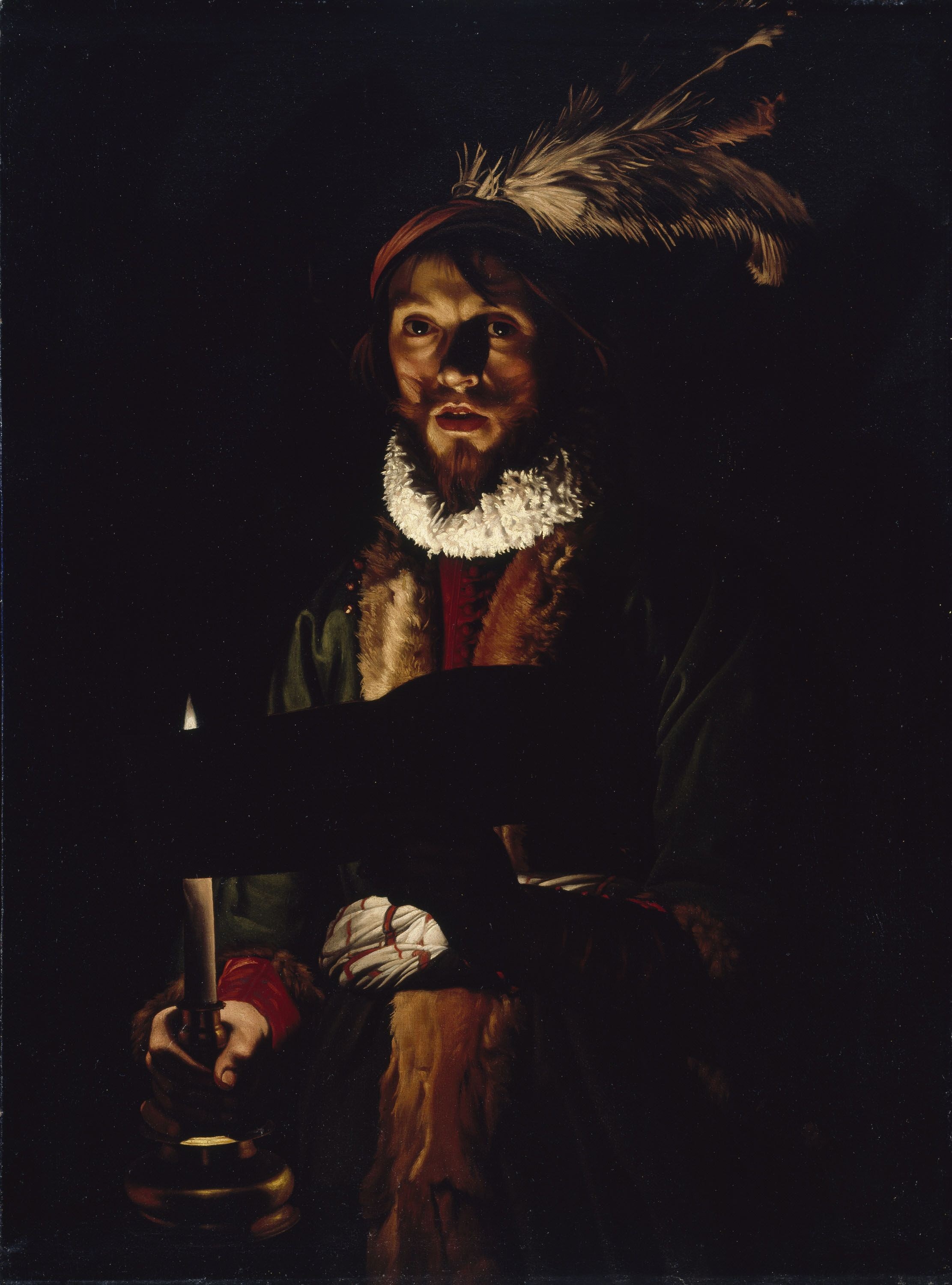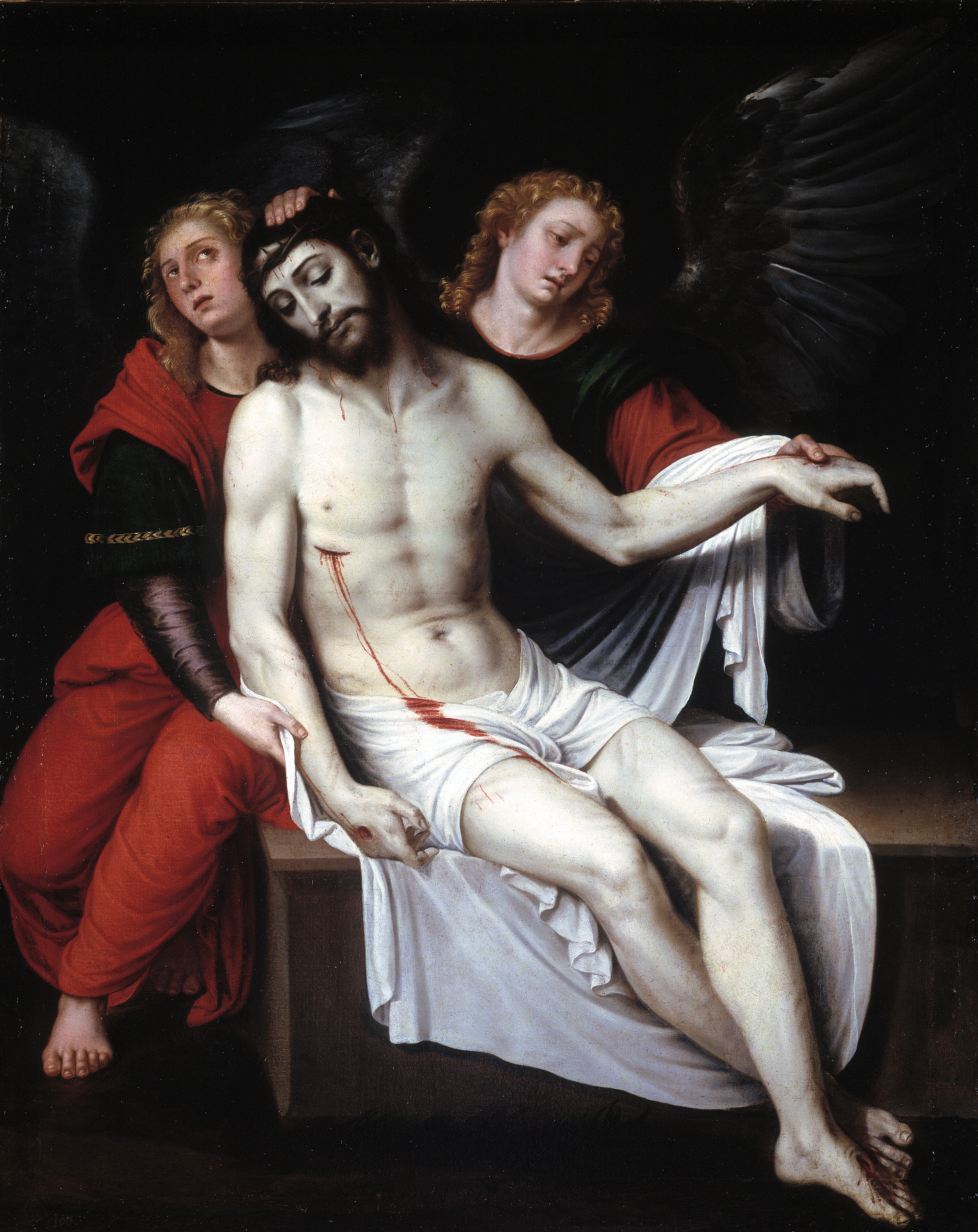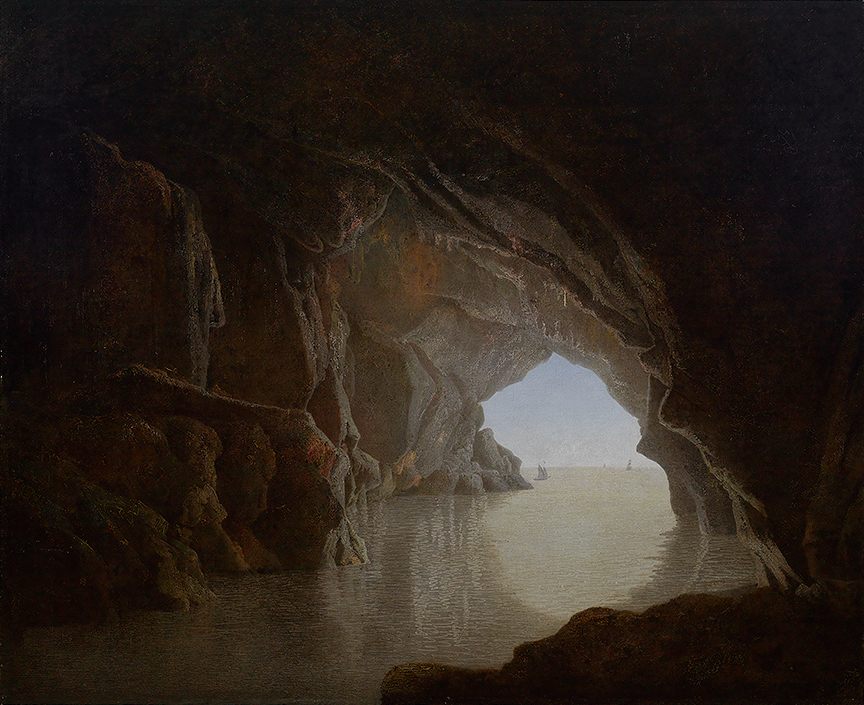|
Tenebrism
Tenebrism, from Italian ' ("dark, gloomy, mysterious"), also occasionally called dramatic illumination, is a style of painting using especially pronounced chiaroscuro, where there are violent contrasts of light and dark, and where darkness becomes a dominating feature of the image. The technique was developed to add drama to an image through a spotlight effect, and is common in Baroque paintings. Tenebrism is used only to obtain a dramatic impact while chiaroscuro is a broader term, also covering the use of less extreme contrasts of light to enhance the illusion of three-dimensionality. Baroque The artist Caravaggio is generally credited with the invention of the style, although this technique was used by earlier artists such as Albrecht Dürer, Tintoretto and El Greco. The term is usually applied to artists from the seventeenth century onward. Artemisia Gentileschi, a rare female artist of the Baroque and a follower of Caravaggio, was an outstanding exponent of tenebrism. ... [...More Info...] [...Related Items...] OR: [Wikipedia] [Google] [Baidu] |
Georges De La Tour
Georges de La Tour (13 March 1593 – 30 January 1652) was a French Baroque painter, who spent most of his working life in the Duchy of Lorraine, which was temporarily absorbed into France between 1641 and 1648. He painted mostly religious chiaroscuro scenes lit by candlelight. Personal life Georges de La Tour was born in the town of Vic-sur-Seille in the Diocese of Metz, which was technically part of the Holy Roman Empire, but had been ruled by France since 1552. Baptism documentation revealed that he was the son of Jean de La Tour, a baker, and Sybille de La Tour, née Molian. It has been suggested that Sybille came from a partly noble family. His parents had seven children in all, with Georges being the second-born. La Tour's educational background remains somewhat unclear, but it is assumed that he traveled either to Italy or the Netherlands early in his career. He may possibly have trained under Jacques Bellange in Nancy, the capital of Lorraine, although their styles ... [...More Info...] [...Related Items...] OR: [Wikipedia] [Google] [Baidu] |
Chiaroscuro
Chiaroscuro ( , ; ), in art, is the use of strong contrasts between light and dark, usually bold contrasts affecting a whole composition. It is also a technical term used by artists and art historians for the use of contrasts of light to achieve a sense of volume in modelling three-dimensional objects and figures. Similar effects in cinema, and black and white and low-key photography, are also called chiaroscuro. Further specialized uses of the term include chiaroscuro woodcut for coloured woodcuts printed with different blocks, each using a different coloured ink; and chiaroscuro drawing for drawings on coloured paper in a dark medium with white highlighting. Chiaroscuro is one of the canonical painting modes of the Renaissance (alongside cangiante, sfumato and unione) (see also Renaissance art). Artists known for using the technique include Leonardo da Vinci, Caravaggio Rembrandt, Vermeer and Goya, and Georges de La Tour. History Origin in the chiaroscuro drawing The ter ... [...More Info...] [...Related Items...] OR: [Wikipedia] [Google] [Baidu] |
Jusepe De Ribera
Jusepe de Ribera (1591 – 1652) was a painter and printmaker, who along with Francisco de Zurbarán, Bartolomé Esteban Murillo, and the singular Diego Velázquez, are regarded as the major artists of Spanish Baroque painting. Referring to a series of Ribera exhibitions held in the late 20th century, Philippe de Montebello wrote "If Ribera's status as the undisputed protagonist of Neapolitan painting had ever been in doubt, it was not longer. Indeed, to many it seemed that Ribera emerged from these exhibitions as not simply the greatest Neapolitan artist of his age but one of the outstanding European masters of the seventeenth century."Pérez-Sánchez, Alfonso E., and Nicola Spinosa. 1992. Jusepe de Ribera 1519–1652'. The Metropolitan Museum of Art/Harry N. Abrams, Inc. New York. 290 pp, Jusepe de Ribera () has also been referred to as José de Ribera, Josep de Ribera, and Lo Spagnoletto ("the Little Spaniard") by his contemporaries, early historians, and biographers ... [...More Info...] [...Related Items...] OR: [Wikipedia] [Google] [Baidu] |
Francisco Ribalta
Francesc Ribalta (2 June 1565 – 12 January 1628), also known as ''Francisco Ribaltá'' or ''de Ribalta'', was a Spanish painter of the Baroque period, mostly of religious subjects. Biography He was born in Solsona, Lleida. Although his first apprenticeship was apparently with Navarrete, who worked for years in the Escorial, Ribalta's earliest work (a ''Cruxifixion'' of 1582) was signed in Madrid. After his years in Madrid, Ribalta was to settle as an artist in Valencia. He became among the first followers in Spain of the austere tenebrist style of Caravaggio. It is unclear if he directly visited either Rome or Naples, where Caravaggio's style had many adherents. Alternatively, it is likely that tenebrist paintings were available in Spain by the early 17th century through the Spanish rule of the Neapolitan kingdom. Jusepe de Ribera is said to have been one of his pupils, although it is entirely possible that Ribera acquired his tenebrism when he moved to Italy. Style ... [...More Info...] [...Related Items...] OR: [Wikipedia] [Google] [Baidu] |
Utrecht School
Utrecht Caravaggism ( nl, Utrechtse caravaggisten) refers to the work of a group of artists who were from, or had studied in, the Dutch city of Utrecht, and during their stay in Rome during the early seventeenth century had become distinctly influenced by the art of Caravaggio.Murray, P. & L. (1996), ''Dictionary of art and artists''. Penguin Books. Upon their return to the Dutch Republic, they worked in a so-called Caravaggist style, which in turn influenced an earlier generation of local artists as well as artists in Flanders. The key figures in the movement were Hendrick ter Brugghen, Gerrit van Honthorst and Dirck van Baburen, who introduced Caravaggism into Utrecht painting around 1620. After 1630 the artists moved in other directions and the movement petered out. The Utrecht Caravaggisti painted predominantly history scenes and genre scenes executed in a realist style. [...More Info...] [...Related Items...] OR: [Wikipedia] [Google] [Baidu] |
Sotheby's
Sotheby's () is a British-founded American multinational corporation with headquarters in New York City. It is one of the world's largest brokers of fine and decorative art, jewellery, and collectibles. It has 80 locations in 40 countries, and maintains a significant presence in the UK. Sotheby's was established on 11 March 1744 in London by Samuel Baker, a bookseller. In 1767 the firm became Baker & Leigh, after George Leigh became a partner, and was renamed to Leigh and Sotheby in 1778 after Baker's death when Leigh's nephew, John Sotheby, inherited Leigh's share. Other former names include: Leigh, Sotheby and Wilkinson; Sotheby, Wilkinson and Hodge (1864–1924); Sotheby and Company (1924–83); Mssrs Sotheby; Sotheby & Wilkinson; Sotheby Mak van Waay; and Sotheby's & Co. The American holding company was initially incorporated in August 1983 in Michigan as Sotheby's Holdings, Inc. In June 2006, it was reincorporated in the State of Delaware and was renamed Sotheby's. In ... [...More Info...] [...Related Items...] OR: [Wikipedia] [Google] [Baidu] |
Gerrit Van Honthorst
Gerard van Honthorst (Dutch: ''Gerrit van Honthorst''; 4 November 1592 – 27 April 1656) was a Dutch Golden Age painter who became known for his depiction of artificially lit scenes, eventually receiving the nickname ''Gherardo delle Notti'' ("Gerard of the Nights"). Early in his career he visited Rome, where he had great success painting in a style influenced by Caravaggio. Following his return to the Netherlands he became a leading portrait painter. Early life Van Honthorst was born in Utrecht, the son of a decorative painter, and trained under his father, and then under Abraham Bloemaert.Brown (1997), p.62 Italy Having completed his education, Honthorst went to Italy, where he is first recorded in 1616. He was one of the artists from Utrecht who went to Rome at around this time, all of whom were to be deeply influenced by the recent art they encountered there. They were named the Utrecht ''caravaggisti''. The other three were Dirk van Baburen, Hendrick ter Bru ... [...More Info...] [...Related Items...] OR: [Wikipedia] [Google] [Baidu] |
Rembrandt
Rembrandt Harmenszoon van Rijn (, ; 15 July 1606 – 4 October 1669), usually simply known as Rembrandt, was a Dutch Golden Age painter, printmaker and draughtsman. An innovative and prolific master in three media, he is generally considered one of the greatest visual artists in the history of art and the most important in Dutch art history.Gombrich, p. 420. Unlike most Dutch masters of the 17th century, Rembrandt's works depict a wide range of style and subject matter, from portraits and self-portraits to landscapes, genre scenes, allegorical and historical scenes, biblical and mythological themes and animal studies. His contributions to art came in a period of great wealth and cultural achievement that historians call the Dutch Golden Age, when Dutch art (especially Dutch painting), whilst antithetical to the Baroque style that dominated Europe, was prolific and innovative. This era gave rise to important new genres. Like many artists of the Dutch Golden Age, ... [...More Info...] [...Related Items...] OR: [Wikipedia] [Google] [Baidu] |
Adam De Coster
Adam de Coster (c. 1586 in Mechelen – 4 May 1643 in Antwerp) was a Flemish painter. He was a prominent member of the Antwerp Caravaggisti. These Caravaggisti were part of an international movement of European artists who interpreted the work of Caravaggio and the followers of Caravaggio in a personal manner.Anna Orlando, ''Schede in Lights and Shadows. Caravaggism in Europe, catalogo della mostra, Cesare Lampronti Gallery, London, 2015'' pp. 76-77 He is mainly known for his |
Adam Elsheimer
__NOTOC__ Adam Elsheimer (18 March 1578 – 11 December 1610) was a German artist working in Rome, who died at only thirty-two, but was very influential in the early 17th century in the field of Baroque paintings. His relatively few paintings were small scale, nearly all painted on copper plates, of the type often known as cabinet paintings. They include a variety of light effects, and an innovative treatment of landscape. He was an influence on many other artists, including Rembrandt and Peter Paul Rubens. Life and work Elsheimer was born in Frankfurt am Main, one of ten children and the son of a master-tailor. His father's house (which survived until destroyed by Allied bombs in 1944) was a few metres from the church where Albrecht Dürer's ''Heller Altarpiece'' was then displayed. He was apprenticed to the artist Philipp Uffenbach. He probably visited Strasbourg in 1596. At the age of twenty, he travelled to Italy via Munich, where he was documented in 1598. His ... [...More Info...] [...Related Items...] OR: [Wikipedia] [Google] [Baidu] |
Godfried Schalcken
Godfried Schalcken (1643 – 16 November 1706) was a Dutch genre and portrait painter. He was noted for his mastery in reproducing the effect of candlelight, and painted in the exquisite and highly polished manner of the Leiden fijnschilders. Life and work Godfried Schalcken was born in Made, North Brabant, the son of Cornelis Schalcken and Aletta Lydius. Before he was four years old, his family moved to Dordrecht, where his father became rector of the Latin school. Schalcke studied under Samuel van Hoogstraten in Dordrecht before he moved to Leiden, into the studio of Gerard Dou (1613–1675), one of Rembrandt's most famous pupils. His earlier genre pictures very closely resemble Dou's work. He worked in Leiden until c. 1675, then returning to Dordrecht until 1691, after which he settled in The Hague, where he continued to paint until his death, near age 63, in 1706. He also visited England (1692–1697), but his uncouth manners and bad temper alienated him from the society t ... [...More Info...] [...Related Items...] OR: [Wikipedia] [Google] [Baidu] |
Joseph Wright Of Derby
Joseph Wright (3 September 1734 – 29 August 1797), styled Joseph Wright of Derby, was an English landscape and portrait painter. He has been acclaimed as "the first professional painter to express the spirit of the Industrial Revolution". Wright is notable for his use of tenebrism, an exaggerated form of the better known chiaroscuro effect, which emphasizes the contrast of light and dark, and for his paintings of candle-lit subjects. His paintings of the birth of science out of alchemy, often based on the meetings of the Lunar Society of Birmingham, a group of scientists and industrialists living in the English Midlands, are a significant record of the struggle of science against religious values in the period known as the Age of Enlightenment. Many of Wright's paintings and drawings are owned by Derby City Council, and are on display at the Derby Museum and Art Gallery. Life Joseph Wright was born in Irongate, Derby, to a respectable family of lawyers. He was the thir ... [...More Info...] [...Related Items...] OR: [Wikipedia] [Google] [Baidu] |



.jpg)





_-_Portrait_of_Adam_de_Coster_(cropped).jpg)

